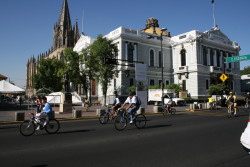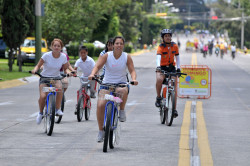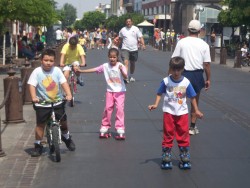ViaRecreActiva Metropolitana
Guadalajara, Mexico
Source: Pedestrian and Bicycle Information Center (PBIC)
Problem
Municipality officials sought to diminish barriers which had developed between neighborhoods of differing social standing. Due to a lack of sidewalks and an excess of drivers on roads, there was a need for public open space devoted solely to non-motorists to travel and socialize in. Through the creation of a public gathering space welcoming to all residents, regardless of social status, municipalities hoped to build community amongst its citizens.
Background
Av. Vallarta, El Paraninfo de la Universidad de Guadalajara de Fondo.
Image: Fomento Deportivo de Guadalajara
Guadalajara's neighborhoods had become divided into two distinct groups, the old and the new. The newer neighoborhoods housed a majority of the city's residential development and economic opportunities, leaving the other without. Ongoing urban development had been further dividing these neighborhoods, increasing the separation between the varying social classes. One of the main intentions behind ViaRecreActiva was to provide a common space for members of all neighborhoods to interact.
Solution
The inspiration for ViaRecreActiva came from Bogota, Colombia. A Spanish word meaning "bike path", Ciclovia, first began in the 1970s, and, over the past forty years, it has become a core element of Bogota culture. The city now closes over 70 miles of its streets to motorized vehicles for five hours every Sunday and holiday and opens them to bicyclists, walkers, runners, dancers, and other individuals participating in various activities along the route.
The idea for ViaRecreActiva was first presented to Guadalajara2020, a non-profit citizen-led organization assembled for the primary purpose of implementing the ViaRecreActiva program, by Enrique Penalosa in 2003. Enrique Penalosa was the mayor of Bogota, Colombia, from 1998 to 2001, and, among other things, Enrique and his brother, Guillermo, are credited with making the Ciclovia a program as successful as it is in Colombia, and the rest of the world, today. The Council of the Metropolitan Zone of Guadalajara was invited to witness the event in person in Bogota, Colombia, in 2003. A year later, Guadalajara hosted its first Cicloviaprogram, titling it ViaRecreActiva, a name that combines "active" and "recreation".
Results
Calle Beethoven in Zapopan.
Image: Comude, Zapopan
ViaRecreActiva began as an 8km (5 miles) route in Guadalajara, Mexico, in September of 2004. Today, five municipalities in the area each host a route from 8 A.M. to 2 P.M. every Sunday and over 300,000 individuals participate each week. Four of the five routes are connected, for a total route length of 64.3 km (40 miles). In Guadalajara, Avenue Vallarta-Juarez from Glorieta Minerva (a large traffic circle and well-known landmark) to Avenida Javier Mina was chosen as the central route for several reasons. Not only is it a major road in the city, but the architecture lining the route holds cultural and historic importance. The route showcases the architectural styles of different periods in Guadalajara's urban growth, from its founding in the 1500s up until the 1970s. This unique and historic environment makes the route a pleasant space to walk through, as individuals along the promenade experience a sort of "timeline" of the city through its urban form. In addition to this, a parallel road has many restaurants and cafes which stay open during the weekly event, offering participants other places to visit and socialize with each other besides the route.
Main Street of Tlaquepaque.
Image: Municipio de Tlaquepaque
The emphasis of the event is on providing a public gathering space for people and on making that public gathering space comfortable yet active. Thus, individuals are discouraged from using the event to advertise for either business or political purposes, or from generating income off of participants. Only established business along the route and those with official permission are allowed. Additionally, throughout the route activities such as aerobics and skating classes, chess games, music concerts, and capoeira demonstrations, among others, are offered. Two private companies lend bicycles during the event, at no cost to participants. Residents only need to leave an ID to borrow a bike, and receive the ID back when the bicycle is returned. This allows individuals without a bike to experience the route in a different way. In return, the companies gain publicity and free advertising.
Each of the five municipalities has a local coordinator responsible for organizing the route in their respective district. Residents and participants are the ones responsible for watching over and continuing the program. Guadalajara2020 has served as a unifying force, working for the improvement and growth of Route Metropolitan RecreActiva.
The main benefit of the program has been social integration. Neighborhoods previously divided by social status are now interacting. Individuals are playing on sports teams together and several citizen advocacy groups have formed to promote bicycle use in the city. The reactions to and outcomes of the ViaRecreActiva program have been positive and many residents and families now look forward to the event each week.
Contact
Municipality Coordinators:
ZAPOPAN - Lucy Barriga, lucybarriga@gmail.com, tel 37001797
GUADALAJARA - Sandra Rios, siannia@hotmail.com, tel 30550600 (ext 137)
TLAQUEPAQUE - Angelica Martel, amartel@hotmail.com, tel 12016908
TONALA - Alba Mireles, amireles@tonala.gob.mx, tel 12016908 (ext 3916)
TLAJOMULCO - Mercedes Gomez, mercedes07villalobos@hotmail.com, tel 32834400
Author
Monica Leap, monicaleap@gmail.com







